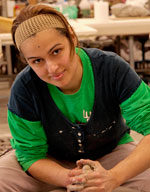By: Cassie Ingram, Transcript correspondent

A professor at Ohio Wesleyan University makes dirty clay water almost clean enough to drink using clay filtration pots.
In 2009 the Fine Arts department hosted Peter Chartrand, the director of Potters for Peace organization (PFP), where he introduced the filtration pots to some of the professors and explained the organization’s intentions and goals.
Their goal as an organization is to create a simple and easy to use water purifier for developing nations.
After hearing about PFP Kristina Bogdanov, associate professor of Fine Arts, was encouraged to create these similar pots for her classes in hopes of developing them and making them even better. Although her first intentions were to make them to be sent across the world she was unable to, so she stuck to using them on campus.
“Thanks to the suggestion from Joan McLean, professor of politics and government, I began using the clay filters to filter waste water from the ceramics studio,” said Bogdanov. Her objectives are to keep harsh chemicals out of our tap and drinking water.
Student in the ceramics studios were instructed to use a certain wash bucket to wash out containers with glazes in them, brushes, sponges, and any tools that are dirty. After that, the dirty water gets poured into one of the clay pots. After a few days the water filters through the clay leaving clay residue and other chemicals in the bottom of the clay pot and clean water in the bucket underneath.
How do these clay pots work? When the clay is fired the partials create a chain like affect, making it very difficult for anything besides water to get through.
According to the PFP website, this alone cleans about 98 percent of the water, but that still leaves two percent of unclean water. So for that two percent they coat the pots with a silver lining. The silver penetrates the pours of the pots and bonds with the iron oxide in the clay.
This boost the effectiveness of the filter to 99.98 percent.
Currently, Bogdanov is working on a new design for the filter in hopes of making it portable. Her hope is to create them so they can be sent and used in other countries to make safe drinking water.
PFP stands to educate and get people to understand how big of a problem unsafe drinking water is in other countries, and now Ohio Wesleyan has the opportunity to be a part of this movement and help other countries.